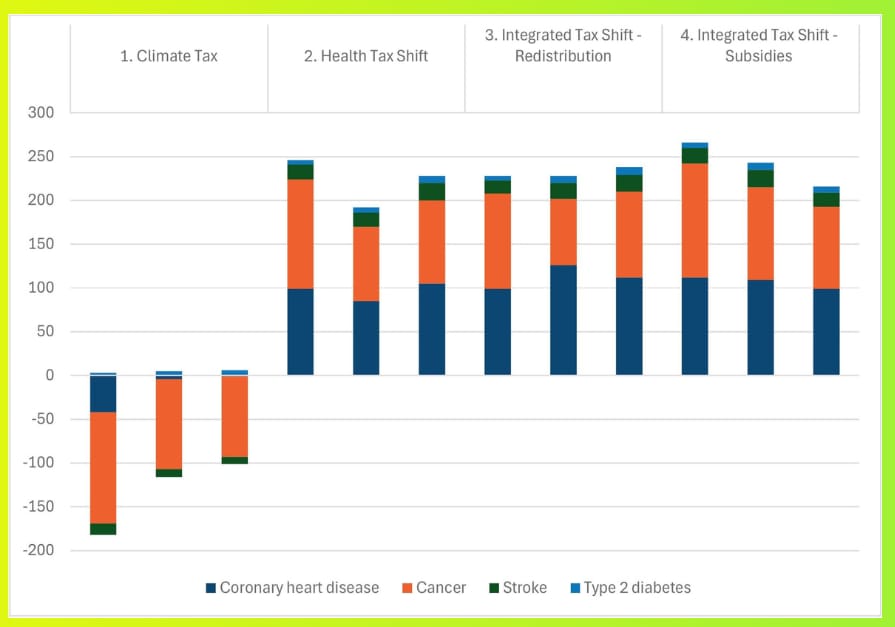
Get smarter about food tech, sustainability & food innovation — in just 3 minutes.
Welcome to VITAMIN C®
If you missed the last editions, check them out here.
Read time today: 3:12 min
Hi friend,
It’s Friday morning. You are reading VITAMIN C 🍋.
There are 5M+ posts this week about food tech, sustainability and food innovation. I hunted down the 5 that deserve your attention.
Here they are:
1. [Science | Reports] ⚖️ Tax the problem, not the people.
Food taxes are unpopular. But what if you could cut emissions, improve public health, and not punish the poor?
A group of researchers from Sweden designed a tax system that:
Hits high-emission foods (like beef), leading to an 8% drop in climate emissions
Rewards healthy foods (like legumes & whole grains) through tax subsidies
Keeps total food costs stable - no increase in anyone’s grocery bill

This graph above shows the estimated number of premature deaths avoided (or caused) per year under four potential types of food tax reforms in Sweden:
Climate tax on CO₂-heavy foods
Health tax on unhealthy foods
Integrated Tax Shift - Redistribution: Tax on CO₂-heavy foods and subsidies for healthy foods such as fruits and whole grains
Integrated Tax Shift - Subsidies: 0% VAT for healthy foods
The effects are shown for low-income (left bar), middle-income (center bar), and high-income (right bar) earners.
The results look almost too good to be true.
More about the study here.
2. [Food for Thought] 💉 What GLP-1s are doing to the food industry

In NYC, bar-&-burger restaurants like Clinton Hall have introduced teeny-weeny menus: 50g burger patties (half of usual size) and 150ml drinks.
Why? Because millions of people are now injecting GLP-1s (like Ozempic and Wegovy), suppressing appetite, shrinking cravings, and turning full-size meals into food waste.
Meanwhile, Oikos Yogurt (owned by Danone) just launched Oikos Fusion, a yogurt-drink explicitly built for GLP-1 users: 23 g protein, 5 g pre-biotic fibre, vitamin D + whey/leucine blend.
A new normal is setting in, and it’s reshaping the food economy:
↳ U.S. households with one GLP-1 user cut grocery spending by 5.5% in 6 months
↳ Snack purchases are down as much as 11%
Food & beverage brands can’t keep doing “more of the same”.
With a growing GLP-user base, new rules enter the game: smaller portions, higher-nutrient content, fewer snacks.
More insights about this topic here.
3. [People & Startups] 🕵️♀️ The startup founder decoding consumers

Please meet Julia Kirsch, a loyal VITAMIN C reader and the mastermind behind Volto AI.
Most brands think they know their customers. Julia decided to actually prove it.
With Volto AI, she’s building a way to understand people as they really behave, not just what they self-report in a survey.
Her platform Volto AI listens to real-time customer signals and turns them into deep audience insights brands can act on instantly.
I love this.
If you want to learn more, connect with Julia directly.
4. [Recommendation] 📖 Book: “Unreasonable hospitality”

At the 3-star restaurant Eleven Madison Park, its founder Will Guidara overheard guests saying they had tried many fancy meals during their stay in NYC but didn't have a “real New York hotdog.”
So Will sent a staff member out to buy a hot dog just on the street. The chef rearranged and served it with a fancy sauce.
The guests were blown away.
That’s when Will realized: the magic in hospitality isn’t in perfection, it’s in paying attention.
In making people feel seen.
In listening so closely, you can surprise them with what they didn’t even know they wanted.
Will is convinced that this mindset was the secret to turning Eleven Madison Park into the best restaurant in the world.
He captured his insights in his book Unreasonable Hospitality.
It’s super useful not only for restaurant owners but for pretty much anyone working with people.
5. [Inspiration] 🎯 You can’t fix what you haven’t defined

How often do we rush to fix something before we’ve even defined the problem?
I’ve lost hours (sometimes days) jumping straight into solutions instead of spending five quiet minutes writing down what’s actually broken.
Kidlin’s Law says: “If you write down a problem clearly and specifically, you’ve already solved half of it.”
And it’s true.
Because clarity is strategy.
A lot of “solutions” in FoodTech fail not because they’re wrong but because the problem was never clear.
So here’s a challenge for you this week:
Write down the biggest problem you're facing in your business - in one sentence.
Read it out loud.
If it still feels true when spoken clearly, you’ve achieved clarity. And clarity is half the battle in solving anything.
Stay awesome,
Lia

How did you like today's email?
Enjoyed this newsletter? Let’s keep the conversation going on LinkedIn!
Or forward this email to a food & sustainability-curious friend - because good ideas are better when shared. 🙌
